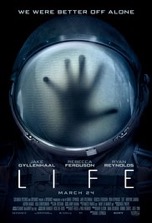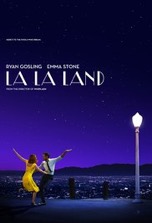April 2017
Life (R)
19/04/17 13:18 Filed in: 2017

Starring: Jake Gyllenhaal
March 2017
What follows is the full-length review based on comments that were originally tweeted in Real-time from the back row of a movie theater @BackRoweReviews. Though efforts were made to tease rather than ruin this movie’s memorable lines and moments, some spoilers may exist in the following evaluation. For concerns over objectionable content, please first refer to one of the many parental movie guide websites. Ratings are based on a four star system. Happy reading!
It’s very tempting to call Life a cheap knockoff of Alien and just leave it at that. Actually, Life pilfers from other sci-fi movies too, like the recent Passengers. Both films open with a meteor shower wreaking havoc on a spaceship and end with one male and one female survivor who must save that ship and humanity as we know it. Granted, what lies between those narrative bookends is divergent to the extreme. The Alien comparison is more apropos since the bulk of Life’s story deals with a too strong, too fast and too smart creature that slinks about the ship picking off one cardboard character at a time. Like so many sci-fi and horror creature features these days, there’s no emotional impact when characters die because we have no personal connection to them—a failure on the part of the writers to customize personality traits and construct compelling back stories. But character development isn’t the only area of the movie where screenwriters Rhett Reese and Paul Wernick were derelict. Plot holes large enough to fly a Soyuz spacecraft through bedevil a story that already has problems with pitch and yaw thanks to its derivative storyline and plot contrivances. These contrivances, designed to keep the thrills coming at a rapid pace, are so daft they make you want to throw your bucket of popcorn at the movie screen. Chief among these inanities is the poorly designed exhaust manifolds (or some other such technobabble) on the ship’s thrusters. The creature will enter the ship unless the crew engages the thrusters to flush it out of the engines, but commencing a burn will put the ship on a collision course with Earth’s atmosphere. So the lesser of two evils is to let the creature back into the ship where they hope to kill it, despite the fact that they didn’t even come close to doing so earlier. Utter tripe! The creature design and FX that brought it to life are absolutely spectacular. As such, the creature’s greatest flaw doesn’t come from the drawing board but from the script. Rhett and Wernick, along with director Daniel Espinosa, made the creature too indestructible. The fact that a Martian creature can thrive in an oxygen environment is dubious from the start, but when that squid-like blob can outsmart humans at every turn…on their own turf? C’mon! At the very least, you’d expect the stellar cast to be able to pull the story out of its tailspin, but due to the poorly drawn characterizations, such is not the case. The fact that Ryan Reynolds’ wise-cracking character (a slightly toned down version of the titular antihero in Deadpool) can never keep his mouth shut is ultimately his undoing. Jake Gyllenhaal and Rebecca Ferguson make the most of what they’re given, which isn’t much aside from running and shouting. One of the only things the film gets right is that the black guy (Ariyon Bakare) isn’t the first character to die. However, this one eschewed stereotype doesn’t make up for the virtual procession of tired thriller tropes employed by the movie. Well, there you have it—this is Life or something like it. Actually, due to its hunter/hunted plot, this movie should’ve been called Death. Unless you’re pulling for the Martian creature, in which case the current title works just fine.
Logan (R)
03/04/17 00:41 Filed in: 2017

Starring: Hugh Jackman
March 2017
What follows is the full-length review based on comments that were originally tweeted in Real-time from the back row of a movie theater @BackRoweReviews. Though efforts were made to tease rather than ruin this movie’s memorable lines and moments, some spoilers may exist in the following evaluation. For concerns over objectionable content, please first refer to one of the many parental movie guide websites. Ratings are based on a four star system. Happy reading!
Logan is Hugh Jackman’s ninth X-Men film and his third solo outing as Wolverine. Sadly, after seventeen years of portraying feral mutant, Logan marks Jackman’s final appearance in the franchise. Just as attrition has finally set in for the 48-year-old actor, Logan can no longer heal as quickly as when he was younger and feels the sting of every bullet that impacts on his adamantium exoskeleton more acutely than in his prime. Whereas Logan’s pain is physical, Charles Xavier’s (Patrick Stewart) is mental. In fact, the usually well composed Professor X, Logan’s longtime mentor, is losing his mind to the ravages of dementia. If you’ve ever wondered what would happen if Professor X got really mad and unleashed all of his mental powers into one furious barrage (like Cyclops without his shades), you’ll definitely want to keep an eye out for the movie’s psionic blast sequences…amazing FX. For two characters who started off on rough footing, Charles and Logan have become good friends; you might say they’re almost like a non-related father and son. The scenes where Logan, dutiful son, takes care of Charles, aging parent, are genuinely moving. It’s profoundly sad to see such a brilliant a mind wasting away, but Father Time eventually catches up to everyone, even mutants it would seem. The film’s family connection extends to Laura (Dafne Keen), a young girl who exhibits Logan’s ferocity while fighting and possesses his ability to rapid heal. Logan, directed by James Mangold (Walk the Line), is essentially a pursuit film with Logan attempting to outrun his past so that he can simply fade into obscurity. Although there are plenty of elaborately choreographed action sequences, the story occasionally stops to corral stray horses, which detours the through-line and delays the film’s mission. These scenes are a double-edged sword since they slow down the action in order to provide meaningful character moments, which effectively ground the story and prevent its more spectacular elements from running away with the show. Still, without episodes like the dinner at the farmer’s house, the film would have far less heart. Once the “special” bullet (similar in concept to a silver bullet for a werewolf) is introduced we have a pretty good idea of how it will be used—and, indeed, the ending is painfully obvious. Even though Wolverine’s demise is precipitated by a pulse-pounding fight sequence, he still deserved a more spectacular, more heroic sendoff. However, the scene where Logan passes the torch to the next generation of mutant heroes is heartwarming. So where does the franchise go from here? Will Marvel bestow Wolvie’s claws, laconic speech and rugged mien on a younger actor? Will Laura lead a whole new team of mutants? One thing’s for sure, the X-Men franchise will never be the same. But we can take solace in knowing that Logan/Jackman went out on top in, arguably, the first mature superhero movie ever made.
La La Land (PG-13)
03/04/17 00:40 Filed in: 2016

Starring: Ryan Gosling
December 2016
What follows is the full-length review based on comments that were originally tweeted in Real-time from the back row of a movie theater @BackRoweReviews. Though efforts were made to tease rather than ruin this movie’s memorable lines and moments, some spoilers may exist in the following evaluation. For concerns over objectionable content, please first refer to one of the many parental movie guide websites. Ratings are based on a four star system. Happy reading!
During the opening musical number in La La Land, appropriately staged on a L.A. freeway, I thought: “Dear God, what have I gotten myself into?” Based on that intro, I thought the remainder of the movie would be comprised of similarly elaborate musical numbers performed at regular intervals throughout the film. Much to my relief, I was wrong. The movie quickly transforms into an engaging romance/drama with only the occasional song and dance number interspersed throughout the narrative. What ensues is a follow-your-dreams tale where Sebastian (Ryan Gosling), a struggling piano player, wants to open his own jazz club and Mia (Emma Stone), a frustrated barista, wants to become a famous actress. Writer/director Damien Chazelle cannily delays the romance between Sebastian and Mia by arranging a series of anti-meet cutes, which should be a sign to the couple that their love affair is destined to be ill-fated. Casablanca (1942) is referenced a few times in the film and holds obvious significance for the star-crossed couple, particularly in how both films end. LLL seeks to tap into the brilliance of such masterpieces as Casablanca for its dramatic passages and Singin’ in the Rain (1952) for its musical routines. The film is brimming with classical Hollywood nods like the old film posters that adorn the walls of Mia’s bedroom and the Sebastian and Mia’s screening of Rebel Without a Cause (1955) at the Rialto Theater. As such, LLL is a reimagining of the Hollywood musical, a largely retired genre. Ironically, relying so heavily on Golden Age Hollywood themes and iconography has proven to be a double-edged sword for the film. On the one hand, the heavy quotation of vintage films has established the film’s look, mood and atmosphere as well as produced feelings of nostalgia in viewers enamored with such films. On the flip side, it could be argued that the film relies too heavily on early Hollywood tropes and that such an effort was done intentionally, to play on viewer’s emotions and to pander to those in the industry, particularly Academy members. Either way, LLL fails to achieve its goal since it doesn’t adhere to classical modes of storytelling. Indeed, the movie is a mélange of genres (comedy/drama/musical/romance) and is, perhaps, too ambitious for attempting to combine so many disparate story elements. One of those aspects is the jazz appreciation subplot. Whereas keeping the arts alive is an important endeavor, the obvious validation of jazz as an essential, vibrant art form is foisted on the audience and such advocacy is just one more objective the film tries to accomplish. Though many of the film’s romance scenes feel trite, Chazelle’s concluding “the life that would have been” parallel action device is brilliantly executed and infuses the film with an unexpectedly bittersweet resolution. In the end, LLL’s story is the only thing that holds it back from becoming an instant classic. The film’s directing, acting, production values, locations, cinematography and music (especially Justin Hurwitz’ “City of Stars,” which has a wistful “Moon River” quality) are all off the charts. Gosling and Stone’s (in their third movie collaboration) screen chemistry is so searing it nearly makes the film melt, something that actually happens during Sebastian and Mia’s screening of Rebel. There’s far more that works here than doesn’t, and at the end of the day, the film’s unique vision has broadened the appeal and potential for the modern musical. LLL seems to be a strong contender to win Best Picture. It just depends on what Academy voters are in the mood for this year: depressing drama (Hell or High Water, Manchester by the Sea, Moonlight), historical biopic (Hacksaw Ridge, Hidden Figures), inspiring true story (Lion), space invasion flick (Arrival), converted stage drama (Fences), or this film. We’ll find out soon enough.